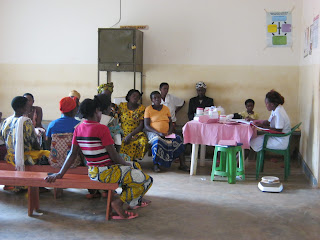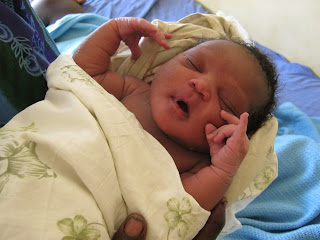
Joy my Congolese translator traveled for three days to the border of Uganda to escape the war carrying whatever he could. He was perhaps around 14 years of age. He was separated from his parents who escaped with his younger siblings. In some way it was blessing in disguise. Joy was registered separately and received his own refugee card which entitled him to a plot of his own land, tarp, blankets and cookware. It was also fortuitous that his family was placed close to him. It has been over fifteen years since he came to Uganda. He learned English in Ugandan school besides French that he learned in the Congo. He translates for Joshua and me, but mostly for me since Joshua could often get by using the local language. Despite all the hardship Joy has a temperament that goes along with his name. He always greets me with this wide, white-teeth joyful smile that is quite contagious. It has been a JOY and a PLEASURE working with him.
My first week here I showed him the lyrics to “Joy to the World or Jeremiah was a bullfrog” by Hoyt Axton, just the refrain,
Joy to the world
All the boys and girls
Joy to the fishes in the deep blue sea
Joy to you and me
It brought the biggest grin from him.
He would like to return home but is afraid of the insecurity of the situation in Congo. Two of his siblings have elected to stay in the Congo and are now studying in the university, supporting themselves by selling properties that the family owns in the Congo. Periodically Joy wires money to them when they are in dire need because he is the oldest. He says that he will go back when it is God’s will.
Joy is insistent about being able to tell a Rwanda refugee from a Congolese from the way they dress. But I am convinced that he is aided by their accent, language and their names. Here are two women, one from Rwanda and the other from the Congo and I can’t tell where they are from just by looking at them and for that matter I can’t tell a Ugandan national from the refugees. The women here wear clothing with a whole variety of colors and materials often mixing them in ways that I am not used to. There are no distinct differences that I can discern but evidently there must be.


Moses (Moses 2) who translated for me one day when Joy was not around, has a similar story except that he was around three when he came here. For him he would prefer to stay in Uganda and become a citizen. Uganda is all he knows. He has lived here almost all of his life and knows only English and does not think he will fit well in the Congo. Just like Joy how he ends up will be God’s will.

Mary runs the immunization clinic in one of the open-air buildings. The immunizations offered to the children include polio, measles, DTP (diphtheria, tetanus and pertussis). For the women in reproductive age she ensures that they are immunized against tetanus. There is also a clinic that she provides vitamin A to the children. On Wednesdays she runs a “Growth Monitoring Clinic” when babies are weighed and measured looking for malnourished children and providing education about nutrition and in some circumstances, nutritional supplementation.


Rosette and Amulet are the two midwives in the health center, the prettiest midwives that I have ever met. They run the antenatal clinic on Mondays and Fridays in addition to delivering babies. There is HIV testing and counseling. Roughly 6% of the pregnant women are tested positive for HIV. There is a maternity ward of two beds and one could stretch it to three if one is forced to use the bed in the consultation room. The delivery room is next to the ward. One of the mid-wives is always on call at night and oftentimes they spend the night there with the mother-to-be.


In the Injection room, Moses (Moses 1) and Jocelyn could place IVs expertly even in the tiniest wriggling baby. They are a crucial part of the team in the health center. Harriet and Jeffrey run the laboratory. The injection room and the laboratory are places that the children fear most. Crying often emits from these rooms and they are reluctant dragons when it is their turn to face the music.


Then there are Olivier and Alice who dole out the medications, Patrick who registers the demographics of the patients who have been seen; there are many more personnel that I don’t know who make the day-to-day functioning of the clinic possible. Kibengo Health Center also runs a community out reach service twice a week. I am not familiar with the program since being the only doctor here I was told from the outset that my place is at the center itself.
Joshua is the medical officer with whom I share a consultation room. We saw patients simultaneously on each side of the desk, not much privacy for our patients. If I have to do a gynecological exam, I would take my women to the maternity consultation room. For the men who complain of ailments below the waist, I would empty our consultation room of patients for my exam. Joshua is unlike most African medical people I work with does his physical exam which is quite refreshing indeed. Most African doctors just talk to their patients and prescribe them medications without performing a physical examination.
Speaking of physical examination, I saw a man with insomnia, he told us that he became “crazy” last January and was admitted and then medicated. I decided to do a fairly complete physical examination on him and sent him home on some diazepam (sleep aid). The following week he brought his wife and insisted that she should see me. She also was hospitalized roughly at the same time for psychotic problem and came in for insomnia. He told Joy that he himself has been sleeping well since he had the complete treatment from me. He wanted his wife to get the same physical exam that he received from me. Well if that made him happy, I was glad to comply. Such is the healing power of the laying of the hands.
Joshua is also in charge of the treatment of TB and keeps a record of all the patients who have been sent to get sputum testing. All the patients who are sent for TB testing also receive HIV testing. From my rough calculation, about 5% of the patients tested are positive for TB but 25% of patients suspected of TB are tested positive for HIV.
The clinic sees between 250 to 350 patients a day. Sixteen staff members live in the quarters behind the clinic, two to a room. Many of them have families far away and yet I have not heard any mutterings of dissatisfaction among the staff. They have to use the latrines, no flushed toilets or running water. There is a very thriving vegetable garden in the yard with lots of onions, corn, tomatoes, pumpkins, passion fruits, groundnuts and ododo. There are many more administrators and support staff that I have not mentioned and they also make the place whirl.

Last week Rosette showed me a new-born baby, soft, innocent and vulnerable. He was the mother’s first and she seemed exhausted but grandmother was extremely proud and eager to show off her grandson. Rosette was just as proud.

No comments:
Post a Comment